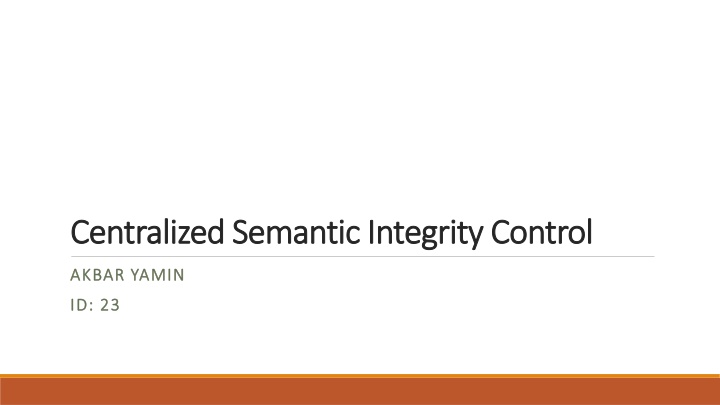
Centralized Semantic Integrity Control in Databases
Explore the concept of centralized semantic integrity control in databases, including specification of integrity constraints, enforcement methods, and more. Learn how constraints play a crucial role in maintaining data consistency and reliability.
Download Presentation

Please find below an Image/Link to download the presentation.
The content on the website is provided AS IS for your information and personal use only. It may not be sold, licensed, or shared on other websites without obtaining consent from the author. If you encounter any issues during the download, it is possible that the publisher has removed the file from their server.
You are allowed to download the files provided on this website for personal or commercial use, subject to the condition that they are used lawfully. All files are the property of their respective owners.
The content on the website is provided AS IS for your information and personal use only. It may not be sold, licensed, or shared on other websites without obtaining consent from the author.
E N D
Presentation Transcript
Centralized Semantic Integrity Control Centralized Semantic Integrity Control AKBAR YAMIN AKBAR YAMIN ID: 23 ID: 23
Outline Centralized Semantic Integrity Control Specification of Integrity Constraints Integrity Enforcement Distributed Semantic Integrity Control
Specification of Integrity Constraints 1. Integrity constraints can be defined either at relation creation time, or at any time, even if the relation already contains tuples. 2. SQL standard provides means to express the propagation of update actions to correct inconsistencies. Triggers (event-condition-action rules) can be used to automatically propagate updates, and thus to maintain semantic integrity. 3. In relational database systems, integrity constraints are defined as assertions. An assertion is a particular expression of tuple relational calculus 4. Through them, it is possible to express concisely the more common constraints of the relational model, such as non-null attribute, unique key, foreign key, or functional dependency
Specification of Integrity Constraints 1. Precondition constraints express conditions that must be satisfied by all tuples in a relation for a given update type. 2. The update type, which might be INSERT, DELETE, or MODIFY, permits restricting the integrity control. 3. To identify in the constraint definition the tuples that are subject to update, two variables, NEW and OLD, are implicitly defined. They range over new tuples (to be inserted) and old tuples (to be deleted), respectively
Specification of Integrity Constraints Precondition constraints can be expressed with the SQL CHECK statement enriched with the ability to specify the update type. The syntax of the CHECK statement is
Integrity Enforcement The first one is based on the detection of inconsistencies. The update transaction is executed, causing a change of the database state D to updated state. The enforcement algorithm verifies, by applying tests derived from these constraints. The second method is based on the prevention of inconsistencies. An update is executed only if it changes the database state to a consistent state. The tuples subject to the update transaction are either directly available (in the case of insert) or must be retrieved from the database.
